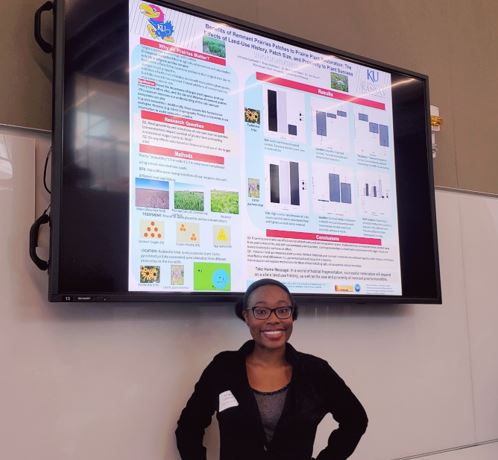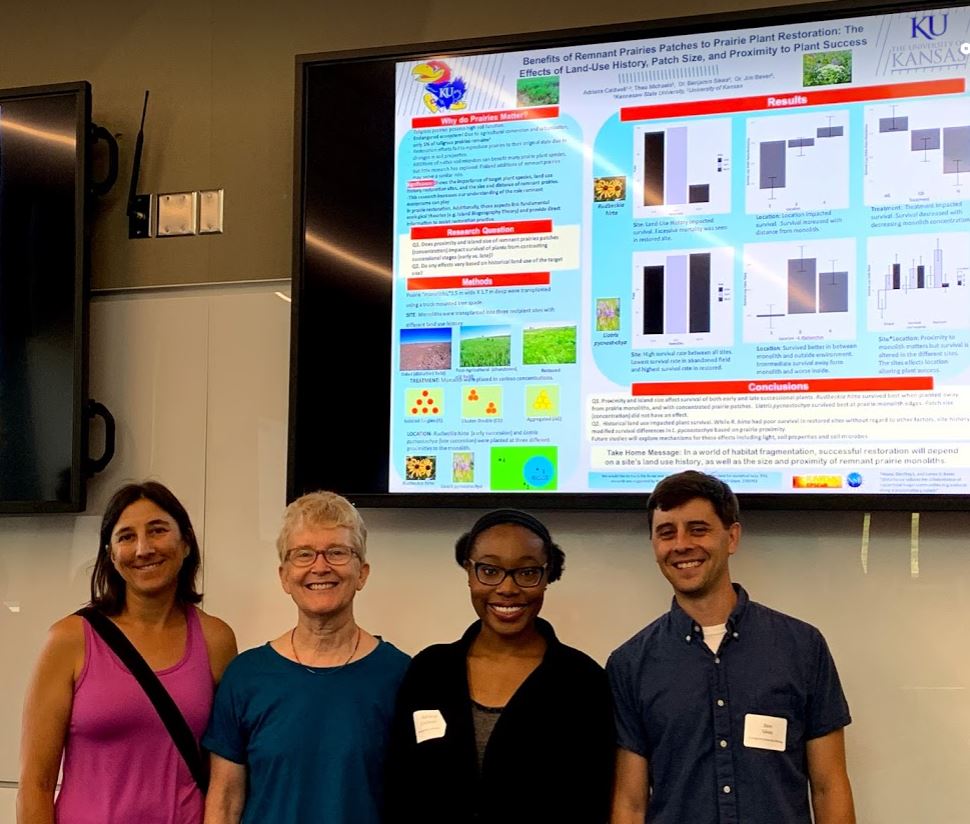

It was her high school biology teacher, Mrs. Schudder, who “kick-started” Andriana Caldwell’s passion for science. She explained “While in high school and then in college, I had a huge passion for microbiology. My passion first ignited in my 11th grade AP Biology class. It was wonderful to learn the effects of the smallest microorganisms on animals and plants, how tiny nucleic acids make us what we are today, and how every item on earth has a microscopic atomic structure. I really enjoyed learning the interactions between microbiology and other domains of life. Thus, I wanted to apply my knowledge from my classes into research.” Andriana found an opportunity to conduct research when she participated in the 2019 MAPS Summer Research Experience for Undergraduate (REU) students at the University of Kansas (KU). The MAPS REU program is one of the educational initiatives supported by the Kansas NSF EPSCoR RII Track-1 Award OIA-1656006: Microbiomes of Aquatic, Plant, and Soil Systems across Kansas (MAPS). Her research mentors were Theo Michaels, Ph.D. Ecology and Evolutionary Biology (EEB) student with the Sikes’ Lab; Dr. Ben Sikes, Associate Professor of EEB, Associate Scientist for the Kansas Biological Survey, and MAPS team leader for plants and soils research group, and Dr. Jim Bever, Distinguished Foundation Professor of EEB, Senior Scientist at the Kansas Biological Survey and Co-PI for the Kansas NSF EPSCoR MAPS project.
The title of her project was Benefits of Remnant Prairies Patches to Prairie Plant Restoration: The Effects of Land-Use History, Patch Size, and Proximity to Plant Success, and she describes her research as follows:
“Prairie ecosystems are declining. Only ~4% of the tall grass prairie remains due to agricultural conversions and human land-use. Because of this, the abiotic and biotic soil composition is altered making restoration efforts challenging. Studies have shown that native microbial additions into soil enhance prairie restoration goals, but we do not know how concentration and proximity of microbial communities affect prairie restoration. This research aims to address the following question: does concentration and proximity to native prairie microbial additions influence prairie plant growth from different successional stages across different land-use history?
Methodology/Tests
Monoliths (large intact soils and plants) were added and transplanted into recipient sites of different land-use histories: a restored, post-agricultural, and disked site at different concentrations (isolated, clustered, and aggregated). We used Rudbeckia hirta and Liatris pycnostachya which differ in their successional stages when planted at different proximities to the monolith concentration.
Conclusions
- Q1. Proximity and island size affect the survival of both early and late successional plants. Rudbeckia hirta survived best when planted away from prairie monoliths, and with concentrated prairie patches.
Liatrispycnostachya survived best at prairie monolith edges. Patch size (concentration) did not have an effect. - Q2. Historical land-use impacted plant survival. While Rudbeckia hirta had poor survival in restored sites without regard to other factors, site history modified survival differences in Liatrispycnostachya pycnostachya based on prairie proximity.”
Andriana presented her research at the 2019 KU Summer Undergraduate Research Poster Session, at the 2019 Georgia Undergraduate Research Conference at the University of West Georgia, and at the 2019 State Louis Stokes Alliance for Minority Participation STEM Innovators Conference where she was awarded 2nd place for oral presentations in the discipline of microbiology.
When asked what she learned from her MAPS REU program, Andriana responded, “the REU summer internship has been one of my life’s best blessings. The internship opened my eyes to a whole new world. It was my first ever field research project, and I had to overcome some hurdles like stamina, dehydration, and labor due to the heat and learn how to code. Since my prior academic focus concentrated on general microbiology and biology, I did not have a background or much interest in ecology. However, after attending this REU program, my entire perspective on ecology changed as I observed and studied first-hand how intricate plants are and their essential role in survival. My perspective on the relationship between soil, microorganisms on plants, and other organisms evolved, and I gained a deeper understanding and appreciation for ecology. Without ecology, life would not exist. It was very cool to learn about the dynamics between plants, animals, and abiotic factors and their connection. After the internship, I enrolled in an ecology course and aced the lab and lecture thanks to what I learned from my REU experience.” She said her favorite part of the experience was “meeting new people and exploring the Kansas landscape,” and she added, “The REU interns and I still communicate until this day, and I sincerely miss Kansas and exploring the city of Lawrence.”
Although she was born in Wichita, KS, Andriana was raised in Stockbridge, GA. She received a National Science Foundation Scholarship and a College of Science and Math Scholarship while attending Kennesaw State University in Kennesaw, GA. While in college, Andriana served as the Secretary for the Biology Student Organization and as the Social Media Coordinator for the Pre-Student Osteopathic Medical Association. Moreover, she co-authored a chapter in the textbook Case Studies in Global Health Policy Nursing titled Pandemics, Epidemics, and Outbreaks: Health Policy Research Priorities that was published in June 2018. She also participated in the Louis Stokes Alliance for Minority Participation Program and was a member of the Minorities in Medicine student organization, the Phi Eta Sigma Honor Society, and the National Residence Hall Honorary. In addition, Andriana was a teaching assistant for the Chemistry 1212 Lab and a microbiology student research assistant, a role that led to her presenting her discoveries at the 2019 National Undergraduate Research Conference (NCUR) held at Kennesaw State University. She also worked on campus as the Advance Office Student Assistant for the Sturgis Library, served as an Odyssey Peer Mentor, and volunteered with the American Medical Women’s Association, the Children’s Healthcare of Atlanta Town Center Urgent Care College, the American Medical Student Association, and the Hands of Hope Clinic. Collecting over 50 hours of observation experience, Andriana had the opportunity to shadow doctors, too. During these observations, she said the doctors allowed her “to handle small tasks in the clinic associated with patients as well as collaborate with them to determine the diagnosis of their patients.” Plus, she added, “I was able to bring items to some patients and tell them small remedies to make relieve their pain.” In December 2019, she presented her independent honors senior capstone project to faculty, guests, and students during the Kennesaw State Honors Senior Capstone Graduation Celebration. The title of her capstone project was Testing the antimicrobial susceptibility of several bacterial pathogens against oyster mushroom (Pleurotus ostreatus) by co-culture and spent media analysis. Following her capstone presentation, she graduated one semester early as an Honors College Research Scholar and earned a Bachelor of Science in Biology with a concentration in Microbiology.
As for her future endeavors, Andriana said, “My plan is to enroll in Medical School and pursue microbiological and clinical research on the side. Hopefully, I will be able to study the microbiological ecology in humans as well.”
